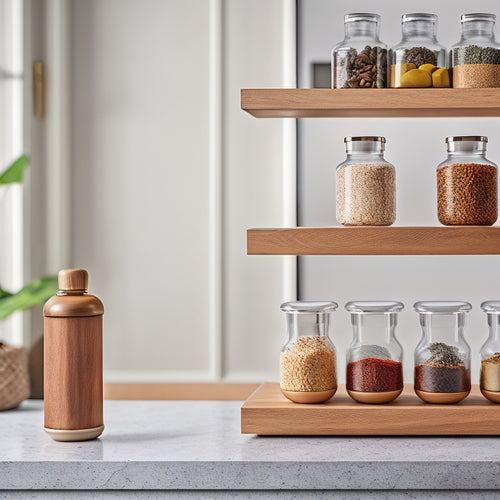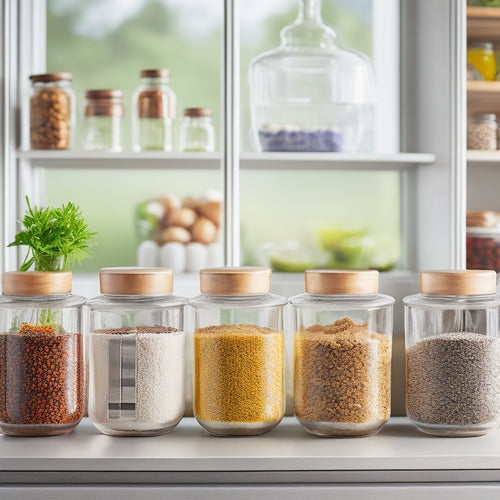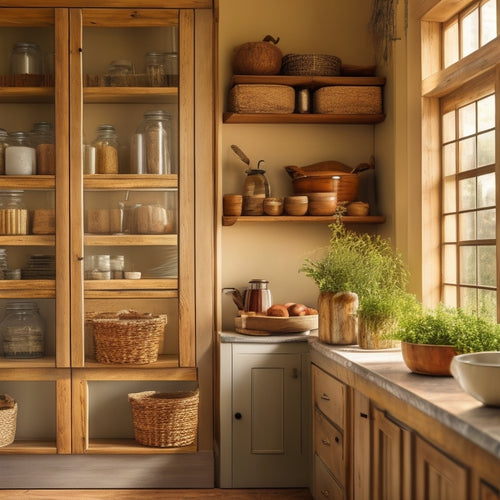
10 Essential Kitchen Pantry Storage Design Tips
Share
You're ready to transform your kitchen pantry from cluttered to calm. Start by evaluating your needs, categorizing items, and measuring your space. Choose storage containers that are sturdy, labeled, and visually appealing. Maximize vertical space with shelves, hooks, and pegboards. Consider curved shelves and Lazy Susans for corners. Design easy access paths with clear aisles and bins. Optimize shelf heights and depths for a functional layout. Incorporate adjustable shelving systems and task-oriented zones. Add a spice rack or drawer for efficiency. By following these essential design tips, you'll open up your pantry's full potential - and discover even more creative solutions awaiting you.
Key Takeaways
• Assess pantry needs by evaluating food types, meal prep frequency, and categorizing items for efficient space allocation and layout planning.
• Utilize vertical space by installing shelves, hooks, or pegboards, and ensure safety with enough clearance between shelves and anti-tip brackets.
• Design easy access paths by planning clear aisle paths, leaving clearance between shelves and walls, and storing frequently used items at eye level.
• Maximize pantry storage capacity by incorporating over-the-door storage racks, pegboards, and wall-mounted shelves for infrequently used items.
• Prioritize frequently used items by storing them at eye level, allocating space based on item sizes, and categorizing similar items together.
Assess Your Kitchen Pantry Needs
Take stock of your kitchen's unique challenges and opportunities by evaluating how you live, cook, and store food in your current pantry setup. This assessment will help you identify areas for improvement and make sure your new pantry design aligns with your specific needs.
Ponder the types of food you store, how often you access them, and the frequency of meal prep. This will aid you in determining the best storage layout and capacity.
Assess your storage needs by categorizing items into groups, such as dry goods, canned goods, and snacks. This will give you a clear picture of what you need to store and how to allocate space effectively. Don't overlook any special requirements, like storing heavy or fragile items.
To utilize space efficiently, think vertically and contemplate installing shelves, cabinets, or a pegboard to maximize storage capacity. Measure your pantry's dimensions and plan your layout accordingly.
Choose the Right Storage Containers
With your pantry's storage needs evaluated, you can now focus on selecting the right storage containers that will keep your food and ingredients organized, visible, and easily accessible. This is an important step in creating a functional and safe kitchen pantry. You want containers that not only store your items but also contribute to the overall aesthetic appeal of your pantry.
When choosing storage containers, consider the following key factors:
-
Labeling system: Look for containers with a built-in labeling system or ones that can be easily labeled using stickers or markers. This will help you quickly identify what's inside without having to dig through contents.
-
Container organization: Select containers that can be stacked or nested to optimize space and promote a clutter-free pantry.
-
Material and durability: Opt for containers made from durable, easy-to-clean materials that can withstand the demands of daily use.
- Size and versatility: Choose containers that come in various sizes to accommodate different items and can be used for multiple purposes.
Utilize Vertical Space Efficiently
By installing shelves, hooks, or a pegboard on the back of a door or wall, you can capitalize on the often-wasted vertical space in your pantry, creating a more streamlined and functional storage area. This vertical organization strategy allows you to maximize your pantry's storage capacity without taking up valuable floor space.
For instance, you can hang baskets or bins containing snacks, spices, or oils, keeping them easily accessible while keeping the floor clear.
In terms of space-saving solutions, consider installing adjustable shelves or a sliding ladder to reach high storage areas. This efficient storage approach guarantees that every inch of your pantry is utilized, making it easier to find what you need when you need it.
A well-designed pantry layout should prioritize functionality and safety, so be sure to leave enough clearance between shelves and consider installing anti-tip brackets to prevent accidents.
Consider Corner Shelving Options
When designing your kitchen pantry, don't overlook corner space - you can maximize this often-neglected area with clever shelving solutions.
You'll want to explore alternatives that make the most of this challenging spot, such as optimizing the corner space with custom shelving or installing carousel shelves that rotate for easy access.
Optimize Corner Space
In the often-wasted real estate of kitchen corners, cleverly designed shelving can access valuable storage and create a sense of airiness. By optimizing this space, you'll not only increase your pantry's storage capacity but also make the most of your kitchen's layout.
Corner shelving options can be customized to fit your specific needs and style.
Here are some ideas to get you started:
-
Curved shelves: These fit snugly into the corner, providing a seamless shift between the wall and the shelf.
-
Pull-out baskets: These allow you to easily access items stored in the back of the corner, reducing the risk of straining or injury.
-
Adjustable shelves: These can be customized to fit different sizes of containers or items, ensuring maximum storage efficiency.
- Lazy Susan: This rotating shelf makes it easy to access items in the corner without having to dig through everything else.
Install Carousel Shelves
To maximize the potential of your kitchen pantry's corner space, consider installing carousel shelves that rotate smoothly, allowing you to effortlessly access items stored in the back. These clever shelves, often referred to as Lazy Susans, are a game-changer for pantry organization. By incorporating them into your pantry layout, you'll create a space-saving solution that's both functional and visually appealing.
When selecting carousel shelves, look for ones with sturdy construction and smooth rotation. This will guarantee that you can easily access items without straining or struggling. Consider installing multiple tiers to maximize storage capacity.
Additionally, think about the type of items you'll be storing on these shelves. If you plan to store heavy or bulky items, choose shelves with extra support or reinforcement.
Design for Easy Access Paths
As you design your kitchen pantry storage, you'll want to create a layout that lets you move easily through the space.
Start by planning clear aisle paths that allow you to reach every shelf and storage area without obstacles.
Clear Aisle Paths First
By designing your kitchen pantry with clear aisle paths, you'll create a functional space that allows you to easily navigate and access your stored items without obstruction. This essential design element guarantees that you can safely move around the pantry, reducing the risk of tripping or bumping into shelves. Clear aisle paths also make it easier to find what you need, saving you time and effort.
To create a pantry with clear aisle paths, consider the following organizing tips and space saving solutions:
-
Leave at least 24 inches of clearance between shelves and walls to establish a comfortable walking path.
-
Install shelves and cabinets with adjustable heights to accommodate items of varying sizes.
-
Use baskets and bins to store small items, keeping them off the floor and out of the way.
- Place frequently used items in easy-to-reach locations, reserving higher or lower shelves for less frequently used items.
Optimal Shelf Height Matters
Your pantry's shelf height determines the ease with which you can access your stored items, making it important to design shelves that cater to your personal comfort and mobility. To achieve the best shelf height, consider your stature and the types of items you'll be storing.
For example, if you're shorter, you may want shelves that are lower to the ground to avoid straining or using a step stool.
When designing your shelves, prioritize shelf organization and space efficiency. Place frequently used items at eye level or slightly below, while less frequently used items can be stored on higher or lower shelves. This layout ensures user accessibility and minimizes bending or stretching.
Additionally, consider installing adjustable shelves to accommodate different sizes of items and to allow for future changes in your storage needs. By optimizing your shelf height, you'll create a pantry layout that's both functional and safe, allowing you to navigate your storage space with ease.
Maximize Door and Wall Space
Maximize Door and Wall Space
Install shelves, hooks, or baskets on the back of the pantry door and adjacent walls to capitalize on often-wasted vertical space and keep essentials within easy reach. This smart design move will help you make the most of your pantry's storage capacity while keeping frequently used items accessible.
By utilizing the back of the pantry door and walls, you'll free up floor and shelf space for other essential items.
Here are some ideas to get you started:
- Use over-the-door storage racks for spices, oils, or snacks
- Install a pegboard on the wall for hanging utensils, bags, or accessories
- Add a wall-mounted shelf for infrequently used items like special occasion dishes or cookbooks
- Incorporate a hidden storage compartment behind a decorative wall panel for valuable or sensitive items
Optimize Shelf Heights and Depths
When designing your pantry's shelf layout, you'll want to make the most of your vertical storage space, ensuring that every inch counts.
By varying shelf depths wisely, you can accommodate items of different sizes and create a visually appealing arrangement.
Now, let's get specific about how to prioritize frequently used items and optimize your shelf heights and depths for maximum efficiency.
Maximize Vertical Storage Space
Tailor your shelves to the items you store, setting up higher shelves for infrequently used or bulk items and shorter shelves for daily essentials, to create a functional and efficient kitchen pantry. This thoughtful approach to pantry organization will help you make the most of your vertical storage space. By doing so, you'll make sure that everything has its designated place, making it easier to find what you need when you need it.
Here are some space-saving tips to maximize your pantry's vertical storage:
-
Install floor-to-ceiling shelves or storage units to utilize every inch of available space.
-
Use stackable containers or bins to store dry goods, keeping them organized and easily accessible.
-
Designate a specific area for heavy or bulk items, such as canned goods or cleaning supplies, to prevent them from falling and causing damage or injury.
- Consider installing pull-out shelves or baskets to make it easy to retrieve items from hard-to-reach areas, reducing the risk of accidents.
Vary Shelf Depths Wisely
By varying shelf depths wisely, you can create a visually appealing and functional pantry that accommodates items of different sizes, from slender spice bottles to bulky cookbooks. This thoughtful approach to depth organization ensures ideal space utilization, making the most of your pantry's real estate.
Custom shelving with varied depths allows you to allocate space according to the items you need to store. For instance, shallow shelves near the front can hold frequently used items like oils and spices, while deeper shelves towards the back can store less frequently used cookbooks or special occasion dishes.
When designing your custom shelving, consider the functionality you need to optimize. For example, if you have a lot of tall items like cereal boxes or cookie jars, you'll want deeper shelves to accommodate them. Conversely, if you have a collection of small items like tea towels or spice jars, shallower shelves will keep them organized and easily accessible.
Prioritize Frequently Used Items
In your pantry, accessibility is key, so position frequently used items at eye level, ensuring they're easily within reach, while reserving lower and upper shelves for less frequently used items. This optimizing technique will save you time and energy in the long run. By prioritizing your kitchen essentials, you'll create a seamless cooking experience.
Here are some organizing tips to keep in mind:
-
Store heavy items, like canned goods, on lower shelves to prevent them from falling and causing accidents.
-
Place spices, oils, and condiments near cooking stations for easy access.
-
Designate a shelf for baking supplies, keeping them separate from savory items.
- Keep infrequently used items, like special occasion dishes, on higher shelves or in harder-to-reach areas.
Incorporate Adjustable Shelving Systems
As you design your kitchen pantry storage, make sure to incorporate adjustable shelving systems that let you customize the layout to fit your unique needs and accommodate items of varying sizes. This feature is essential for space optimization and functionality, ensuring that every inch of your pantry is utilized efficiently. By adjusting the shelves, you can create a tailored space that caters to your specific storage requirements.
For instance, you can allocate more space for bulkier items, such as canned goods or cooking supplies, and less space for smaller items like spices or oils.
Moreover, adjustable shelving systems enable customization and organization, allowing you to categorize and group similar items together. This makes it easier to find what you need when you need it, reducing clutter and chaos in the pantry.
Additionally, adjustable shelves promote safety by preventing overloading and reducing the risk of items falling or toppling over. By incorporating this feature into your pantry design, you'll create a functional, organized, and safe storage space that meets your unique needs.
Add a Spice Rack or Drawer
Designate a dedicated space for your spices by incorporating a spice rack or drawer into your pantry design, ensuring easy access to the flavors and seasonings that elevate your culinary creations. This thoughtful storage solution will keep your spices organized, visible, and within reach, making meal prep a breeze.
Here are some ideas to ponder:
-
Install a pull-out spice drawer that can be customized to fit your specific needs, providing ample storage and easy access.
-
Opt for a wall-mounted spice rack that keeps your countertops clutter-free and adds a touch of visual appeal to your pantry.
-
Incorporate a spice organizer into your cabinet storage, utilizing the back of a door or a narrow cabinet to maximize storage capacity.
- Contemplate DIY solutions, such as repurposing a vintage cabinet or creating a custom spice rack using reclaimed wood, or opt for professional installation for a seamless integration into your pantry design.
Incorporate Task-Oriented Zones
You'll streamline meal prep by creating task-oriented areas within your pantry, each tailored to a specific activity, like food preparation, cooking, or cleaning. This efficient workflow guarantees everything you need is within easy reach, reducing clutter and stress. Imagine having a dedicated area for food prep, complete with a built-in cutting board, utensil storage, and a trash can. Or, a cooking area with a built-in spice rack, oil station, and frequently used cookbooks.
| Area | Key Features | Benefits |
|---|---|---|
| Food Prep | Built-in cutting board, utensil storage, trash can | Reduced clutter, increased efficiency |
| Cooking | Built-in spice rack, oil station, cookbooks | Easy access to essential ingredients and recipes |
| Cleaning | Designated storage for cleaning supplies, trash bags | Quick cleanup and reduced mess |
| Storage | Adjustable shelving, baskets, and bins | Maximizes storage capacity, reduces visual clutter |
Frequently Asked Questions
How Do I Prevent Pantry Pests From Damaging Stored Food?
Like a vigilant dragon guarding treasure, you must shield your pantry from sneaky pests. For pest prevention and food preservation, store food in airtight containers, clean up crumbs, and maintain a tidy pantry with clever storage solutions, ensuring a safe haven for your edibles.
Can I Use the Back of a Pantry Door for Storage?
You can totally utilize the back of a pantry door for storage! Consider installing door storage solutions like baskets, bins, or hooks to maximize space and elevate your pantry organization ideas with creative pantry designs.
What Is the Ideal Pantry Temperature for Food Storage?
You want to maintain a consistent pantry temperature between 50°F and 70°F to guarantee ideal food preservation, as extreme temperatures can affect food quality and safety, which is essential for effective pantry organization.
How Often Should I Clean and Organize My Pantry?
You should clean and organize your pantry every 1-2 months to prevent pest infestations and spoilage, ensuring a safe storage space by maintaining a tidy and structured environment.
Are Pantry Organizers Worth the Investment for Small Kitchens?
You're wondering if pantry organizers are worth the investment for your small kitchen. Yes, they're a game-changer! Invest in space-saving solutions to maximize functionality, or opt for cost-effective DIY organization alternatives that guarantee a safe and stylish kitchen.
Related Posts
-

Modern Countertop Spice Organizer Designs
Modern countertop spice organizer designs enhance your kitchen's aesthetics while maximizing functionality. These spa...
-

Stackable Kitchen Containers for Dry Goods
Stackable kitchen containers are perfect for organizing dry goods and maximizing your kitchen space. They help reduce...
-

Freestanding Pantry Units for Farmhouse Kitchen Style
Freestanding pantry units perfectly blend beauty and function in your farmhouse kitchen. They maximize storage while ...


